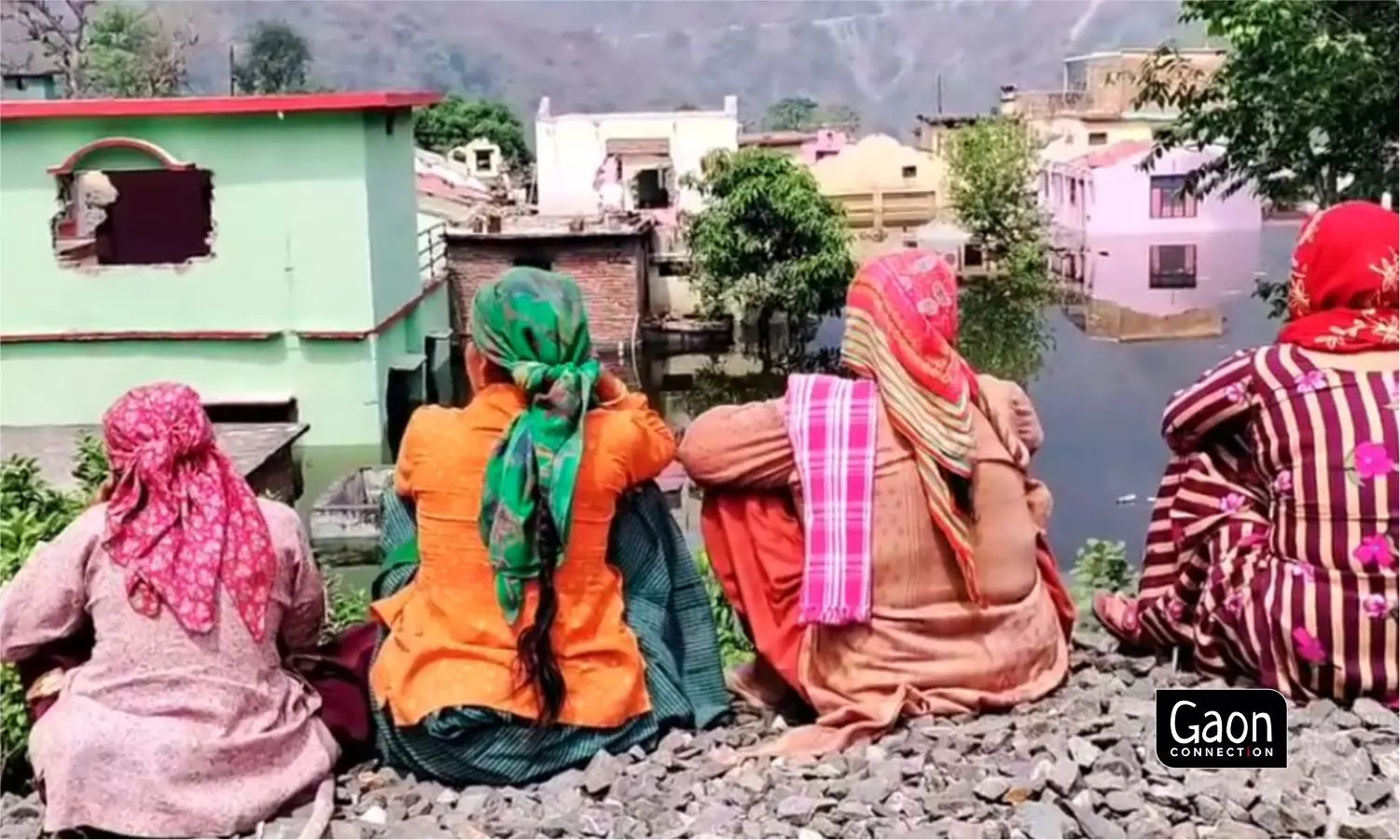Uttarakhand: Lohari village goes under water, displaced villagers demand land for resettlement
About 500 villagers in Uttarakhand’s Lohari village complain that the administration’s two-day notice to shift their belongings to a safer place before the Vyasi dam waters submerged their village, was woefully inadequate. Displaced villagers are demanding a better compensation package.
 satyam kumar 13 May 2022 9:14 AM GMT
satyam kumar 13 May 2022 9:14 AM GMT

Women blankly glazing their homes drowning. All photos: Satyam Kumar
Lohari (Dehradun), Uttarakhand
Gumani Devi, the eldest resident of the Lohari village, gazed blankly at her drowned ancestral house
"I wonder for how many centuries my ancestors lived here. I think I am cursed to witness it drowning in the last few days of my life," the old woman told Gaon Connection.
Devi is one of the estimated 500 people from the Lohari village whose houses were inundated by the waters of the dam last month, on April 9. The dam has been built as part of the Vyasi Hydro Electric Project in the Dehradun district's Kalsi block.
The 120 megawatt (MW) project is set up on the Yamuna river. It is an 86 metres high concrete dam and the water from its reservoir submerged Lohari.
Houses in the Lohari village were inundated by the waters of the dam last month, on April 9.
The villagers allege that the two-day time given to them to shift their entire household was not enough.
"We couldn't uninstall our wooden doors and windows. There's a lot of wood in the houses built on the hills. All that's ruined in water. We should have been given at least a week's notice," Gumani Devi said.
The inundated village was inhabited by an estimated 70 families, many of whom are forced to live in temporary shelters for more than a month now. The displaced families demand that the authorities rehabilitate them in the nearby areas as the compensation offered to their previous generation, when the land was acquired for the project, is 'too less' for them to start their lives from scratch.
Also Read: A Midsummer Pipe Dream: Pipelines laid down and taps installed, but where is the water?
'Refugees in our own lands'
When Gaon Connection visited the dam's reservoir where once Lohari village stood, it found 20 families had temporarily shifted to a local government school while the rest of the village population was staying at their relatives' place in nearby villages.
The displaced families complained of not having access to toilet facilities and water. "We have to order water tankers every now and then to meet our daily requirement. The authorities have simply uprooted us from our homes. We are living like refugees in a place that has been the home to our ancestors for generations," one of the displaced villagers said without revealing his name.
"The authorities were in such a hurry to submerge the area that they did not even consider our crops that could have been harvested in two days. Our wheat crop is rotting in the waters of the dam" Sandeep Tomar, a Lohari village resident, complained.
"We knew we had to vacate the land some day, but had no clue that we'd have to escape like this. We demand that we be resettled as soon as possible," Tomar added.
Compensation package not good enough, say villagers
The villagers allege that the compensation for their submerged lands is not enough.
Dinesh Tomar, secretary of the Lohari Punarvaas Sangharsh Samiti— an organisation representing the interests of the displaced villagers – told Gaon Connection that the administration has acquired more lands than what was originally agreed upon in the 1970s, when the project kicked off.
Also, the activist claimed that the land from Lohari village was acquired in six phases for the project while it was acquired in a single acquisition from other villages in the area.
"What is really awkward is that there are three different blocks here where the land has been acquired — Kalsi, Vikasnagar, and Dhanaulti. The land in these three blocks has been acquired at different rates," said Tomar.
"Our land which falls in the Kalsi block has been acquired at a rate of Rs 36,000 per acre while at other places an acre of land has been acquired for Rs 280,000 per acre. We all have lost our homes, why are different rates being applied," the activist argued.
The villagers allege that the two-day time given to them to shift their entire household was not enough.
The villagers want to be compensated for their loss of lands by allotment of an equal area of lands elsewhere. However, the district administration has refused their demand, they said.
"Almost 40 kilometres away from this place, the administration is providing us plots of 25 square metres and a room. How can a family live in a single room? The surrounding forest areas will not be available for our livelihoods. Also, some of our agricultural fields are still left here, how will we tend to our fields by living so far away," Brahma Devi, a villager told Gaon Connection.
Vinod Kumar, sub-divisional magistrate, Vikas Nagar explained the different compensations.
"The first offer is for those who lost their houses. A total of 16 families have been offered accommodation in compensation while those who already have a house will be provided the rent of their houses for a year," he said. "The families which owned animals or cattle will be provided Rs 8,000 while those who don't will be provided Rs 7,000 per month," he added.
Satyam Kumar is an independent journalist based in Dehradun, Uttarakhand.
#story #uttarakhand #floods
More Stories




